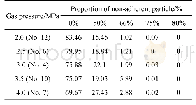《Table 2 Relative atomic content of white particles in different sintering conditions samples by EDS
 提示:宽带有限、当前游客访问压缩模式
提示:宽带有限、当前游客访问压缩模式
本系列图表出处文件名:随高清版一同展现
《"基于TiCN和(Ti,W,Ta)CN的混芯结构金属陶瓷冶金过程中物相、组织结构及力学性能演变(英文)"》
The chemical composition of the white particles from sample C to H(corresponding to Fig.4a to 4f,respectively)was measured on the polished samples by EDS linked with SEM in BSE mode,which are listed in Table 2.The contents of Co and Ni in white particles distinctly increase from 11.03 at%for Co and 7.74 at%for Ni in sample C to27.58 at%for Co and 12.23 at%for Ni in sample D,respectively.This indicates that the solubility of Co and Ni in white particles increases a lot when sintering temperature rises from 1000°C to 1150°C.Therefore,in XRD measurement the higher angle shifting of the(440)peak ofη-phase from 1000°C sintered sample to 1150°C sintered sample in Fig.2 could result from the increased number of Co and Ni atoms dissolved in,causing the decrease of(W,Mo,Ti)/(Co,Ni)atomic ratio,and leading to the lattice constant ofη-phase close to that of W3Co3C.With increasing sintering temperature,the(W,Mo,Ti)/(Co,Ni)atomic ratio increases from 3.50/2.50 at 1200°C(sample E)to 3.59/2.41 at 1250?C(sample F)and then to 3.68/2.32 at1350°C(sample H),which may be the reason that the(440)peaks ofη-phase shifts toward lower angle direction above1250°C in the XRD patterns as the(W,Mo,Ti)/(Co,Ni)atomic ratio inη-phase approaches to W4Co2C.
| 图表编号 | XD0011238400 严禁用于非法目的 |
|---|---|
| 绘制时间 | 2018.05.01 |
| 作者 | 王杰、刘颖、叶金文 |
| 绘制单位 | 四川大学、四川大学、教育部先进特种材料及制备加工技术重点实验室、四川大学 |
| 更多格式 | 高清、无水印(增值服务) |
查看“Table 2 Relative atomic content of white particles in different sintering conditions samples by EDS in Fig.4a~4f”的人还看了
-

- Table 3 Proportion of non-adherent particles under different outgrowth values and atomizing gas pressures
-

- 表2 不同燃料的扩散火焰中碳烟纳米结构参数平均值Tab.2 Mean values of nanostructure parameters of soot particles in different diffusion flames





